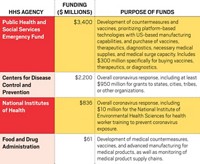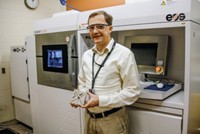Advertisement
Grab your lab coat. Let's get started
Welcome!
Welcome!
Create an account below to get 6 C&EN articles per month, receive newsletters and more - all free.
It seems this is your first time logging in online. Please enter the following information to continue.
As an ACS member you automatically get access to this site. All we need is few more details to create your reading experience.
Not you? Sign in with a different account.
Not you? Sign in with a different account.
ERROR 1
ERROR 1
ERROR 2
ERROR 2
ERROR 2
ERROR 2
ERROR 2
Password and Confirm password must match.
If you have an ACS member number, please enter it here so we can link this account to your membership. (optional)
ERROR 2
ACS values your privacy. By submitting your information, you are gaining access to C&EN and subscribing to our weekly newsletter. We use the information you provide to make your reading experience better, and we will never sell your data to third party members.
Business
Bringing Nanotech To Market
Federal officials look to regional, state, and local initiatives to spur job creation, economic development
by Britt E. Erickson
June 4, 2012
| A version of this story appeared in
Volume 90, Issue 23
Dozens of regional, state, and local initiatives have popped up over the past decade to help commercialize nanotechnology-based products and build a nanotechnology workforce for the future. Many of the initiatives failed to survive the Great Recession because of a lack of state funding, whereas others that involved multiple states withered away because the states did not have common goals.
Today, a handful of state and local nanotech initiatives are speckled across the U.S. Some are seeing signs of success in terms of creating jobs and leveraging private-sector investments in nanotechnology, but many others are struggling to survive.
Each of the initiatives has different goals and funding sources. “If you have seen one of these initiatives, you’ve seen one,” Jim Mason, executive director of the Oklahoma Nanotechnology Initiative (ONI), said last month in Portland, Ore., at a workshop sponsored by the National Nanotechnology Initiative. NNI organized the workshop to get a handle on nanotech efforts beyond the federal level.
NNI began in 2001 as an attempt to coordinate nanotech R&D across 25 federal agencies. It has focused its investments primarily on basic R&D. To date, the federal government has done little to support regional, state, and local nanotech initiatives.
Federal officials are now looking at ways to leverage existing efforts, such as those initiatives, to get basic research into commerce. But because of the eclectic nature of the various efforts, it’s not straightforward. The Portland workshop aimed to map the current landscape of such initiatives, determine what resources are available to drive nanotechnology commercialization, and identify the role nanotechnology can play in future economic growth.
The federal government is feeling pressure to commercialize nanotechnology products after more than a decade of investment in basic nanotech R&D. “We want to build on the 10-year investment in nanotechnology, but build on it in the context of focusing on economic growth and job creation,” said Robert Pohanka, director of the National Nanotechnology Coordination Office (NNCO), which oversees NNI efforts.
Since fiscal 2001, the federal government has invested nearly $18 billion in basic nanotech R&D through NNI. The investments have led to some commercial products, but the bulk of discoveries are sitting in federal laboratories and universities, waiting to be tapped by people who can find a way to use them, Mason said.
Regional, state, and local nanotech initiatives can serve as matchmakers, connecting researchers funded by federal agencies with companies that may benefit from nanotechnology. “Oftentimes, the person who makes the discovery would not think of using it the way a manufacturer would think to use that particular material,” Mason pointed out. “Every day I talk to companies and ask them, ‘What problem have you not been able to solve?’ My goal is to find a nano solution to that problem,” he said.
The Oklahoma Nanotechnology Initiative was fortunate not to have its budget cut during the recession, Mason noted. Established in 2003, ONI is a public-private partnership between the state of Oklahoma’s Center for the Advancement of Science & Technology and the State Chamber of Oklahoma. The program aims to create awareness of nanotechnology and its impact on Oklahoma, and to promote the state as a valuable site for the nanotech industry. The Oklahoma legislature has been funding the program at $1.5 million to $2 million annually.
Oregon also has a successful state-funded nanotechnology effort. Established in 2004, the Oregon Nanoscience & Microtechnologies Institute (ONAMI) uses state economic development funds to provide commercialization money for companies in Oregon. With about $47 million invested by the state of Oregon, companies have raised an additional $103 million, according to Robert D. (Skip) Rung, president and executive director of ONAMI. By Rung’s reckoning, ONAMI’s efforts have created 123 jobs in Oregon.
Another highly successful state-funded effort is a public-private partnership centered in Albany. Formed in 2001, Albany NanoTech Complex started with $50 million in seed money from the state of New York and was able to attract about $3 billion in private-sector investment.
Pennsylvania has one of the oldest and most successful nanotech initiatives, the Nanotechnology Institute, which dates back to 2000 (C&EN, April 2, 2001, page 17). The effort is southeastern Pennsylvania’s first multi-institutional partnership, and it was created by Ben Franklin Technology Partners of Southeastern Pennsylvania, Drexel University, and the University of Pennsylvania. Ben Franklin Technology Partners of Southeastern Pennsylvania has provided more than $55 million to 450 early-stage nanotech companies, which raised about $1 billion in follow-on investments.
Other initiatives have not weathered the economic turmoil as well. For example, the Colorado Nanotechnology Alliance, which was initially funded by a membership association consisting of businesses and service providers such as law firms, became inactive when its funds dried up during the recession. The alliance never received any funds from the state of Colorado.
“The community still exists, waiting to be deployed,” Griff Kundahl told the workshop attendees. Kundahl, the former executive chairman of the Colorado alliance, is now executive director of the Carolina Center of Innovation for Nanobiotechnology, an initiative established in 2009 with $3 million in state funding. The center is focused on nanotechnology-enabled drug delivery and tissue engineering.
Stories similar to Colorado’s could be told for efforts in other states. For instance, the Arizona Nanotechnology Cluster, an effort funded by the nanotech industry without state funds, is struggling to stay alive. For these regional, state, and local initiatives, Kundahl said, “we’ve gotten to a point where it is adapt or die.”
Former NNCO director Clayton Teague, who retired last year, proposed launching an effort to create a nationwide strategic plan to help make regional, state, and local nanotech initiatives more successful. “The first steps would be to decide who would develop the plan and then to define the domain of the plan,” he said. The objective would be to achieve common goals for the initiatives.
Some workshop participants suggested that the federal government should provide funds for regional, state, and local nanotech initiatives, matching the amount contributed by other sources. But when the same suggestion was made at a similar NNI workshop held in Oklahoma in 2009, participants were told that “it is difficult for the federal government to fund individual state and local initiatives,” Mason recalled. They were also told there might be the possibility of federal funds to support multistate and regional initiatives, he said.
Within months of the 2009 workshop, states began forming multistate nanotech initiatives, Mason noted. But the states couldn’t develop a common set of goals, and many of the initiatives struggled to define their vision, Mason said. Federal funding for such regional initiatives never surfaced, and the initiatives were left “withering on the vine,” he said.
Federal funds are even less likely in today’s tight fiscal environment. Therefore, regional, state, and local initiatives have little choice but to sell their programs to the state legislatures and local funding bodies every year.
The number one issue for states right now is job creation, said Mary Jo Waits, director of the Economic, Human Services & Workforce Division of the National Governors Association. Not surprisingly, many regional, state, and local nanotech initiatives have also made job creation a top goal.





Join the conversation
Contact the reporter
Submit a Letter to the Editor for publication
Engage with us on Twitter